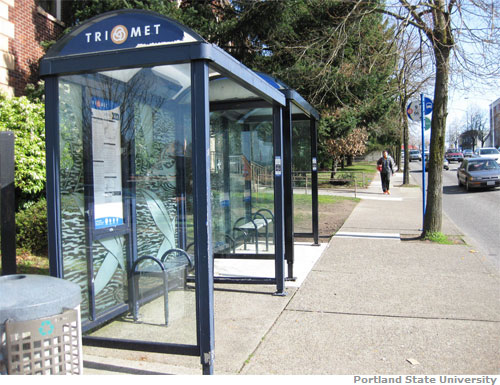You are here
Living Lab Lifts Community Health Into Corridor Performance Discussion
Portland's Southeast Powell Boulevard is more than a major city street and U.S. Highway. It's also a living laboratory for the Oregon Transportation Research and Education Consortium (OTREC), the university transportation center at Portland State University. This laboratory lets OTREC coordinate research on seemingly disparate topics to produce results greater than the sum of their parts.
 A current project on Powell combines research on advanced traffic controls, transit signal priority and air quality to understand how all road users experience a major corridor. The project, which epitomizes OTREC's approach of applying research to create livable communities, grows out of research on pollution exposure for users of each mode.
A current project on Powell combines research on advanced traffic controls, transit signal priority and air quality to understand how all road users experience a major corridor. The project, which epitomizes OTREC's approach of applying research to create livable communities, grows out of research on pollution exposure for users of each mode.
For cyclists, OTREC research has shown how physical barriers and distance from automobile traffic can greatly reduce exposure to the hazardous pollutants known as ultrafine particles. Installing cycle tracks just a few feet farther from tailpipes than a typical bike lane can significantly reduce exposure to these tiny particles, which contribute to a host of ailments.
The same project showed that sound walls have an added benefit beyond dampening highway noise for neighborhoods; they can also clear the air for multi-use paths alongside highways. The research now gives planners a tool to place paths where exposure to pollution will be lowest for pedestrians and cyclists.
Another project looked at how traffic characteristics affect air quality inside vehicles. The most important factor for ultrafine particle exposure inside cars was spacing between cars in traffic.
Fortunately, it's a hazard that travelers have some control over. Just closing the windows cuts pollution inside cars. A simpler step, however, does even more to reduce exposure to these particles, the research found. Closing the car's outside air vent is more than twice as effective as rolling up the windows alone.
Transit passengers aren't lucky enough to have a protective bubble surrounding them. They can wait long periods along the most polluted urban corridors while breathing exhaust from every passing vehicle, including the diesel buses they're waiting for.

OTREC research has found higher pollution levels in road-facing bus shelters such as these than outside the shelters.
In the past, transportation researchers have paid little attention to air quality for transit riders at stops, although research has touched on air quality aboard the buses themselves. Design and location guidelines for bus stops don't even consider air quality.
 Even well meaning design elements can backfire for bus riders. The only amenity most waiting passengers can hope for – the bus shelter – often has the worst air around, according to a finding from the current OTREC project.
Even well meaning design elements can backfire for bus riders. The only amenity most waiting passengers can hope for – the bus shelter – often has the worst air around, according to a finding from the current OTREC project.
According to the research, transit riders waiting in shelters along Powell Boulevard that open toward the road breathe in more pollution than those waiting outside the shelter. It's a problem with a simple solution, however.
Turning the shelter around flips those results. Measurements taken in shelters that open away from the road showed lower concentrations of pollutants than measurements taken outside the shelters. Even without air-quality components, the Powell Boulevard corridor study would be ambitious. This project examines intelligent transportation systems along Powell and how they affect traffic flow, the number of vehicle stops and travel reliability.
Preliminary findings suggest that two innovations studied, advanced traffic control and transit signal priority, have improved the performance of the corridor. Adaptive traffic signal systems installed last fall seem to be working as intended, with both traffic volume and speeds increasing since the systems went online.
Transit signal priority on Powell allows buses to catch more green lights. Early findings show that this helps buses stick to their schedules even when passing through a busy corridor such as Powell.
Work on the project now underway incorporates all these elements into a unified, multimodal view of the corridor. Principal investigator Miguel Figliozzi and his team are now examining how the new signal systems affect traffic queues and how those queues, in turn, affect air quality. The research could have far-reaching effects. As the first project to consider both adaptive traffic control and transit signal priority together, this project helps encourage developers to consider buses alongside cars in their systems. It also allows transportation policymakers to incorporate the health of cyclists, pedestrians and other road users into their decisions.
Transit providers gain a better understanding of stop design and placement and can improve efficiency and reliability, leading to better service for less money. And understanding how all the pieces fit together leads to a smoother trip and better air for everyone.
About This Project
"Integrated multimodal transportation, air quality and livability corridor study, Phase II," is led by principal investigator Miguel Figliozzi and co-investigators Linda George and Christopher Monsere, all of Portland State University. The project, http://otrec.us/project/506, is in partnership with the city of Portland, which will use the results to incorporate health as it improves performance of the corridor for all road users. Justin Carinci is OTREC's director of communications. He spreads the word of OTREC's programs and gets research to the engineers, planners and decision makers who will put it to use.
